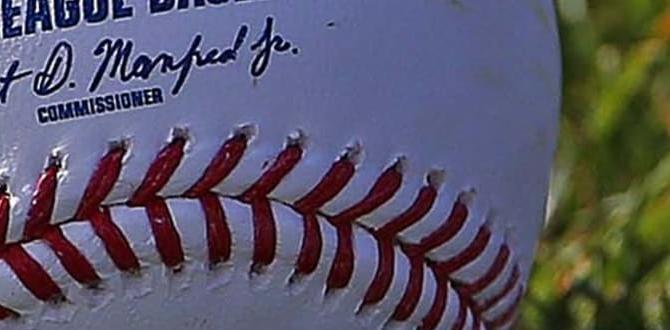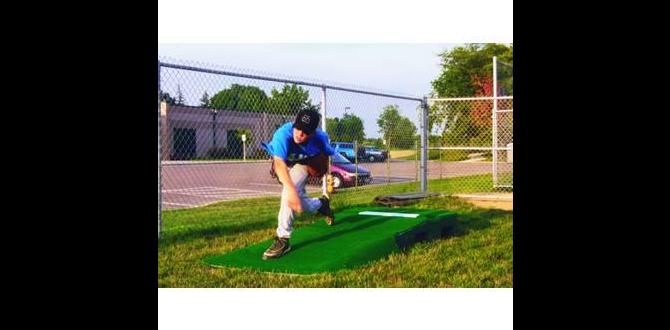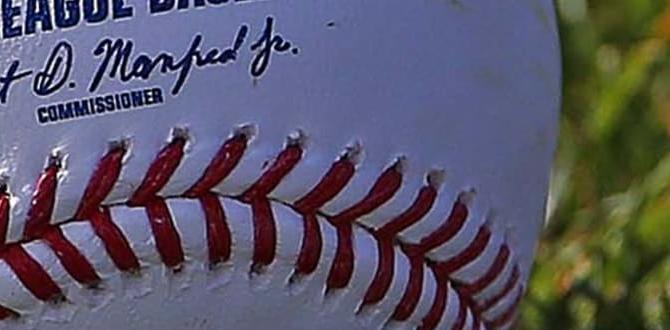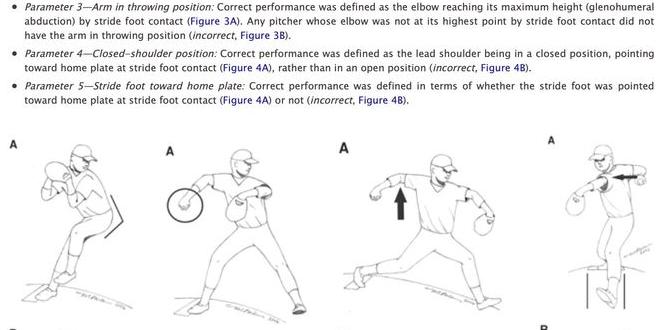Have you ever wondered why some baseball fields look different than others? If you’ve watched a Little League game, you might have noticed the field is smaller than what you see on TV. This is because baseball field dimensions for Little League are specially designed for younger players.
Kids ages 9 to 12 can use shorter distances. For example, the pitching mound is only 46 feet from home plate. This helps them throw strikes and have fun playing. Isn’t that exciting?
Setting these field dimensions helps keep the game enjoyable and safe. It’s not just about the size; it’s about making sure kids can learn and grow. Some young players might not realize these small changes make a big difference.
So, what exactly are the baseball field dimensions for Little League? These measurements create the perfect playground for budding baseball stars. Let’s dive in and explore these fun facts together!
Baseball Field Dimensions For Little League: A Complete Guide

Baseball Field Dimensions for Little League
Little League baseball fields have specific dimensions to ensure fair play and safety. The distance from the pitcher’s mound to home plate is 46 feet, while bases are 60 feet apart. These smaller sizes help younger players develop their skills. Did you know that a standard Little League outfield fence is about 200 feet away from home plate? Understanding these dimensions can help players and parents prepare for practices and games effectively. Keeping the field proper makes baseball fun and exciting!Regulation Dimensions for Little League Fields
Specific measurements for the infield and outfield. Differences between Major League and Little League field dimensions.The magic of baseball starts with the field! For Little League, the infield is usually about 60 feet between bases. That’s shorter than the Major League, where bases are 90 feet apart. The pitcher’s mound for Little League sits 46 feet from home plate, while the big leagues push it back to 60 feet, 6 inches. The outfield can extend up to 200-250 feet, depending on age group. So, Little League fields are like training wheels, helping kids learn before they hit the big leagues!
| Field Dimension | Little League | Major League |
|---|---|---|
| Base Path | 60 feet | 90 feet |
| Pitcher’s Mound | 46 feet | 60 feet 6 inches |
| Outfield Size | 200-250 feet | 300+ feet |
Field Layout and Markings
Description of essential field markings (base paths, pitcher’s mound, home plate). Importance of accurate layout for gameplay and safety.Marking a baseball field correctly is crucial for fun and safety. First, the base paths guide players from base to base, usually 90 feet apart. The pitcher’s mound is at the center, 60 feet 6 inches from home plate. Home plate is where the action starts. Each marking helps players know where to run, throw, and catch. Accurate layout keeps games fair and helps prevent injuries.
What are the key field markings in Little League baseball?
The essential markings include:
- Base Paths: 90 feet apart for running bases.
- Pitcher’s Mound: 60 feet 6 inches from home plate.
- Home Plate: Starting point for batters.
Types of Little League Fields
Variations in field dimensions by age group (Tball, Minor League, Major League). Considerations for allstar and tournament fields.Different age groups play baseball on various field sizes. T-ball fields typically have smaller dimensions to suit young players. As kids grow into the Minor League, fields get bigger. The Major League fields are even larger, with more challenging distances. For tournaments and All-Star games, special fields may combine features from all levels. This ensures every player has a fair shot, no matter their skill level.
What are standard dimensions for different little league ages?
T-ball: 60-foot base paths; Minor League: 60-70 foot bases; Major League: 70-90 foot bases.
Maintenance and Upkeep of Little League Fields
Best practices for maintaining field dimensions and safety. Seasonal considerations for field care and preparation.Keeping little league fields in tip-top shape is like tidying your room—sometimes it’s messy! Make sure to check field dimensions often. The bases should be 90 feet apart, while the pitcher’s mound stays 60 feet 6 inches from home plate. Each season brings its challenges. In spring, groom that grass and fill in holes. Summer? Water the infield and watch for those pesky dandelions! A regular maintenance schedule will help keep everyone safe and speedy on the field. After all, nobody wants to trip over a rogue weed!
| Season | Maintenance Task |
|---|---|
| Spring | Groom grass, fill holes |
| Summer | Water infield, weed control |
| Fall | Prepare for winter, aerate |
| Winter | Inspect equipment, plan for spring |
Benefits of Correct Field Dimensions
Impact on player performance and safety. Longterm advantages for teams and leagues.Getting the field dimensions right can make a big difference in how kids play baseball. Proper sizes can help avoid injuries, allowing kids to run, catch, and throw safely. Plus, it boosts their performance! Teams that practice on correct fields often see better results during games. As they improve, leagues get stronger and more fun. It’s a win-win! You could say it’s like hitting a home run for everybody involved!
| Field Size | Impact |
|---|---|
| 90 ft bases | Improves base running skills |
| 60 ft pitcher’s mound | Better for young pitchers |
| Outfield distance | Enhances catching experience |
In short, correct field dimensions lead to happier players, better teamwork, and a strong league. Who wouldn’t want that?
Resources for Coaches and League Administrators
Links to official Little League resources and guidelines. Recommendations for workshops and field setup training.Coaches and league administrators can find excellent resources to help them guide their teams. Official Little League websites have valuable rules and regulations that every league should follow. Workshops on field setup teach the tricks of the trade for creating amazing baseball fields. These learning sessions can make you feel like a pro! Here’s a quick look at some helpful options:
| Resource | Description |
|---|---|
| Little League Website | Find rules, guidelines, and updates. |
| Workshops | Training on field setup and coaching tips. |
| Community Forums | Connect with other coaches for advice. |
Using these resources can help make your league the best in town. Remember, a happy coach is a winning coach—especially when snacks are involved!
Case Studies of Successful Field Layouts
Examples of welldesigned local fields and their impact on gameplay. Testimonials from coaches and players regarding field experiences.Many local fields have excellent designs that improve gameplay. For example, Community Park Field in Springfield has a balanced outfield. Coaches say it helps players hone their skills. Players enjoy the smooth ground for running and fielding. Here’s what some say:
- “This field is perfect for teaching kids!” – Coach Mark
- “I love how easy it is to hit here!” – Player Jake
Good field layouts boost confidence and teamwork. With well-planned dimensions, players can play their best. Designers should always take note of successful examples!
How do field layouts affect gameplay?
Field layouts influence gameplay by enhancing player movement and skill development. Good design allows players to run and play easily, making games more enjoyable.
Conclusion
In conclusion, knowing the dimensions of a Little League baseball field is important for players and coaches. Bases are 60 feet apart, and the pitcher’s mound is 46 feet from home plate. Understanding these facts helps everyone play the game better. You can explore more about the sport and improve your skills by practicing on a real field!FAQs
What Are The Standard Dimensions Of A Little League Baseball Field In Terms Of Base Paths And Pitcher’S Mound Distance?A Little League baseball field has base paths that are 60 feet long. This means the distance between each base is 60 feet. The pitcher’s mound is 46 feet away from home plate. This setup helps kids play and have fun!
How Do The Field Dimensions Differ For Various Little League Divisions, Such As Minor League Versus Major League?In Little League, the field sizes are different for each division. For the Minor League, bases are 60 feet apart, and the pitching distance is 46 feet. In the Major League, bases are also 60 feet apart, but the pitching distance is longer at 50 feet. This means the Major League field is a bit bigger for the pitcher. Each division is designed for players of different ages and skills.
What Is The Recommended Outfield Fence Distance For Little League Baseball Fields?For Little League baseball fields, the outfield fence should be about 200 feet away from home plate. This distance helps keep the game fun for kids. It makes sure players can hit home runs but still encourages them to run and catch the ball. Remember, it’s all about having a good time while playing baseball!
How Do The Field Layout And Dimensions For Tee Ball Compare To Those For Traditional Little League Baseball?Tee Ball has a smaller field than Little League baseball. The bases are closer together in Tee Ball. This makes it easier for younger kids to run. The pitcher’s mound is also closer to home plate in Tee Ball. Overall, Tee Ball is simpler and more fun for beginners!
What Factors Should Be Considered When Designing A New Little League Baseball Field In Terms Of Safety And Player Experience?When designing a new Little League baseball field, we should think about safety first. We need to make sure the ground is even and free of holes. Also, we should have good fences and padding around hard surfaces. It’s important to have enough space for players to run and play safely. Finally, we should provide shade and seating for fans and players to stay comfortable.
{“@context”:”https://schema.org”,”@type”: “FAQPage”,”mainEntity”:[{“@type”: “Question”,”name”: “What Are The Standard Dimensions Of A Little League Baseball Field In Terms Of Base Paths And Pitcher’S Mound Distance? “,”acceptedAnswer”: {“@type”: “Answer”,”text”: “A Little League baseball field has base paths that are 60 feet long. This means the distance between each base is 60 feet. The pitcher’s mound is 46 feet away from home plate. This setup helps kids play and have fun!”}},{“@type”: “Question”,”name”: “How Do The Field Dimensions Differ For Various Little League Divisions, Such As Minor League Versus Major League? “,”acceptedAnswer”: {“@type”: “Answer”,”text”: “In Little League, the field sizes are different for each division. For the Minor League, bases are 60 feet apart, and the pitching distance is 46 feet. In the Major League, bases are also 60 feet apart, but the pitching distance is longer at 50 feet. This means the Major League field is a bit bigger for the pitcher. Each division is designed for players of different ages and skills.”}},{“@type”: “Question”,”name”: “What Is The Recommended Outfield Fence Distance For Little League Baseball Fields? “,”acceptedAnswer”: {“@type”: “Answer”,”text”: “For Little League baseball fields, the outfield fence should be about 200 feet away from home plate. This distance helps keep the game fun for kids. It makes sure players can hit home runs but still encourages them to run and catch the ball. Remember, it’s all about having a good time while playing baseball!”}},{“@type”: “Question”,”name”: “How Do The Field Layout And Dimensions For Tee Ball Compare To Those For Traditional Little League Baseball? “,”acceptedAnswer”: {“@type”: “Answer”,”text”: “Tee Ball has a smaller field than Little League baseball. The bases are closer together in Tee Ball. This makes it easier for younger kids to run. The pitcher’s mound is also closer to home plate in Tee Ball. Overall, Tee Ball is simpler and more fun for beginners!”}},{“@type”: “Question”,”name”: “What Factors Should Be Considered When Designing A New Little League Baseball Field In Terms Of Safety And Player Experience? “,”acceptedAnswer”: {“@type”: “Answer”,”text”: “When designing a new Little League baseball field, we should think about safety first. We need to make sure the ground is even and free of holes. Also, we should have good fences and padding around hard surfaces. It’s important to have enough space for players to run and play safely. Finally, we should provide shade and seating for fans and players to stay comfortable.”}}]}





